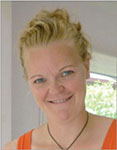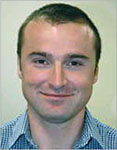Integration of structural, stress, and seismic data to define secondary permeability networks through deep-cemented sediments in the Northern Perth Basin
Adam Bailey A B , Rosalind King B and Guillaume Backé A CA Australian School of Petroleum
B The University of Adelaide
C CO2CRC
The APPEA Journal 52(1) 455-474 https://doi.org/10.1071/AJ11036
Published: 2012
Abstract
Understanding natural fracture networks has increasingly been recognised as an important factor for the prospectivity of a geothermal play, as they commonly exert a prime control over permeability at depth. The onshore Northern Perth Basin provides a good example of how fracture stimulation, and subsequent enhancement of the structural permeability, during hydrocarbon production can enhance flow rate from original tight gas reservoirs. Low primary porosity and permeability values have been initially recorded in the Northern Perth Basin due to silica-rich groundwater infiltration and consequent quartz cementation.
Geothermal energy prospectivity in the region will therefore depend heavily on similar engineering techniques or on the presence of secondary permeability due to interconnected natural fractures. The existence and extent of these natural fractures are verified in this study through an integrated analysis of geophysical logs (including wellbore image logs), wells tests, and 3D seismic data.
Wellbore image logs from 11 petroleum wells in the Northern Perth Basin are used to identify borehole failure (such as borehole breakout and drilling-induced tensile fractures) to give a present-day maximum horizontal stress orientation of N076°E (with an s.d. of 13°). Density logs and leak off tests from 13 petroleum wells are used to constrain the present-day stress magnitudes, giving a transitional strike-slip fault to reverse-fault stress regime in the Northern Perth Basin.
870 fractures are identified in image logs from 13 petroleum wells in the Northern Perth Basin, striking roughly north to south and northwest to northeast. Fractures aligned in the present-day stress field are optimally oriented for reactivation, and are hence likely to be open to fluid flow. Electrically resistive and conductive natural fractures are identified on the wellbore image logs. Resistive fractures are considered to be cemented with electrically resistive cement (such as quartz or calcite) and thus closed to fluid-flow. Conductive fractures are considered to be uncemented and open to fluid-flow, and are thus important to geothermal exploration. Fracture susceptibility diagrams constructed for the identified fractures illustrate that the conductive fractures are optimally oriented for reactivation in the present-day strike-slip fault to reverse-fault stress regime, and so are likely to be open to fluid flow. This is reinforced by the correlation of drilling fluid loss and conductive natural fractures in three wells in the Northern Perth Basin.
To gain an understanding of the extent and interconnectedness of these fractures, it is necessary to look at more regional data, such as 3D seismic surveys. It is, however, well-documented that fault and fracture networks like those generally observed in image logs lie well below seismic amplitude resolution, making them difficult to observe directly on amplitude data. Seismic attributes can be calculated to provide some information on sub-seismic scale structural and stratigraphic features. Using a 3D seismic cube acquired over the Dongara North gas field, attribute maps of complex multi-trace dip-steered coherency and most positive curvature were used to document the presence of natural fractures and to best constrain the likely extent of the fracture network. The resulting fracture network model displays relatively good connectivity, which is likely to extend across much of the basin. These optimally oriented fractures are therefore likely to form a secondary permeability network throughout the cemented sediments of the Northern Perth Basin, offering potential deep fluid flow conduits, which may be exploited for the production of geothermal energy.

Adam Bailey completed his undergraduate studies in geology and geophysics at the University of Adelaide in 2011, graduating with first class Honours from the Australian School of Petroleum. In 2012 he commenced study towards a PhD at the Australian School of Petroleum, focusing on stress and structure in the Otway Basin. adam.bailey@adelaide.edu.au |

Rosalind King completed her BSc (hons) and PhD at the University of Liverpool in 2001 and 2005, respectively. Her PhD research studied the structural evolution of the Cape Fold Belt in South Africa. She worked as a post-doctoral researcher at the Australian School of Petroleum (University of Adelaide) from 2005–10, studying the present-day stresses of northwest Borneo and delta—deepwater fold-thrust belts. She is a lecturer at the School of Earth and Environmental Sciences (University of Adelaide) and her research includes the tectonics of deepwater fold-thrust belts, detachments, fold and thrust mechanics, and petroleum geomechanics. She serves as the president of the South Australian Branch of PESA. Member: GSL, AAPG, PESA. rosalind.king@adelaide.edu.au |

Guillaume Backé is a structural geologist with an expertise in seismic interpretation, three-dimensional structural and geomechanical modeling. He obtained a Master of Geophysics at the University of Toulouse III in France in June 2002, and completed a PhD at the University of Pau et des Pays de l’Adour in 2006. He very recently joined BP as a structural geologist in the Integrated Sub-surface and Description and Modelling team (ISDM), following a two-year Postdoctoral position in the Centre for Mineral Exploration Under Cover (CMXUC) and a three-year lecturing position at the Australian School of Petroleum of the University of Adelaide. Member: AAPG, PESA, AGU and EAGE. guillaume.backe@adelaide.edu.au |


